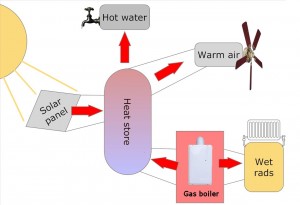7: Space and Water heating – part 2 of 2
Heat storage
In order to make maximum use of any solar energy received heat storage is needed and the most efficient medium for this, without major external excavations, is water. So we need space for a huge hot water storage tank, say 1,000 litres. We are in luck again as the house has a utility room that houses the boiler, amongst the other items. By reducing the boiler size we can turn it from a floor standing device to wall hung. This frees up a section of floor space into which a smaller item can be moved, e.g. the washing machine, that in turn frees up a floor area into which such a large storage tank can be fitted. It’s a real jigsaw puzzle!
This water tank itself is not just a simple tank but one specially designed to handle both the solar and gas heated water inputs, maintaining stratification of the hot water so as to maximise the use of the solar low temperature heating. With such a store, and sufficient solar panels, we aim to be able to minimise the usage of the existing wet radiator system.
With a combination of the above the aim is to provide heating for domestic hot water for well over 80% of the year and to displace the wet heating system in the spring and autumn taking good advantage of solar hot water generation and air heating.
Other heat sources
There are alternatives to this plan such as biomass boilers, air and ground source heat pumps as well as more esoteric solutions that have not been investigated.
Biomass boilers
Biomass boilers are promoted as being green because the burn fuel that has only recently captured the carbon. Unlike coal or gas, they do not release carbon from long term capture; hence they are relatively carbon neutral. The most popular types burn wood pellets or similar.
However, biomass boilers need to run continuously for long periods once lit and considerable storage space is needed for the fuel which is delivered in loads of one or more tonnes. Then there is the necessity for a feeding mechanism, or for manually lifting heavy fuel into a hopper every day, and the disposal of ash.
In our situation we are expecting that intermittent use will be a frequent requirement as the solar assisted heating is expected to take the brunt of the load in the spring and autumn. Only in real winter would a long burning heater be appropriate.
Because of the layout of the building, the ideal location for the boiler is not in a place where fuel can be stored nearby or readily fed. Finally, as the building is to be made airtight, the boiler needs to be of a type that has its own sealed air supply. This increases the cost of the boiler and its installation.
All in all it is not a solution for this application.
Ground source heat pumps
Ground source heat pumps produce heat from the ground by using a kind of reverse refrigeration operation. In essence they multiply the electrical input by between three and five times. So 1 kWh of electrical input gives, say, 4 kWh of heat output. As the temperature of the ground below about 1m is pretty stable throughout the year this is a relatively constant figure.
The heat output is at relatively low temperatures, rather like the solar output, and so requires the same storage and circulation considerations. If underfloor heating were an option then this would be worth more serious consideration as the area to be heated is close to the garden area where the heat source pipes would be laid. However, as the requirement is right at the other end of the house the potential for heat loss is large and, as solar is free once installed, this option has been discarded.
Air source heat pumps
These pumps work in a similar manner to the ground source pumps except that they use air as the source for heat extraction. This makes then inherently less efficient as the temperature of the air does not remain constant but drops when the heating demand is greatest. So their efficiency is much less than the ground source pumps. Enough said.
Provisional conclusion
So the initial thoughts are as follows…
- 1,000 litre hot water store which provides heat for…
- Warm air heating
- Domestic hot water
- Large Solar panels to heat the store
- Gas boiler to supplement the solar when needed
- Gas boiler to feed wet heating when required.
There is a lot of detailed planning necessary to prove the concept and to specify the right equipment to deliver the comfort and savings envisaged.
